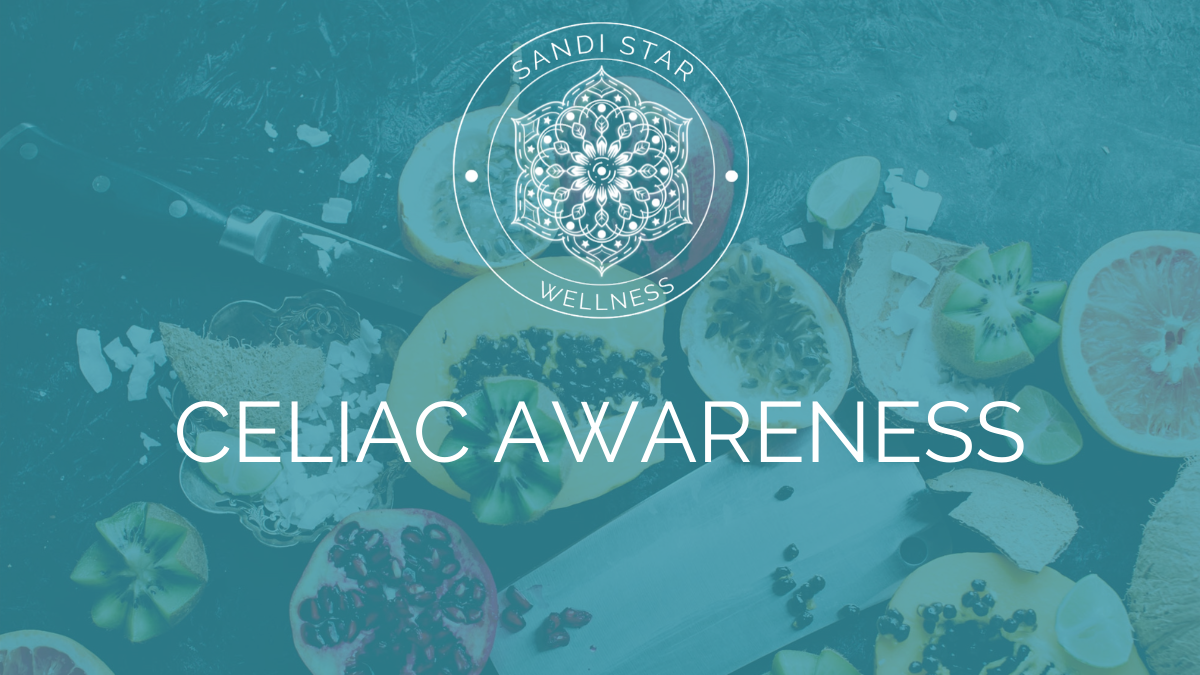
26 Feb Celiac Awareness
Celiac disease affects 1% of healthy, average Americans or 1 in 133. At least 3 million people in our country are living with celiac disease—97% of them are undiagnosed which means the true numbers would be quite a bit larger once we have more awareness for diagnosing early. What I found interesting is 1 in 56 people do not have typical celiac symptoms (GI Distress) meaning celiac affects them systemically (in the body systems) as opposed to the GI tract. There is a long list of systemic issues related to Celiac including neurological such as migraines, ADD/ADHD, depression and anxiety to name a few.
It is estimated that approximately 30% of all celiac disease patients on the gluten-free diet still experience symptoms and/or continued intestinal villi damage which is why we need to go beyond gluten.
In my book Beyond Gluten A Healing Transition (available on Amazon), I put a lot of emphasis in this area to help those with Celiac who are frustrated after going gluten free because they do not heal. With 75% of our immune system in the gut (GI Tract) it’s no wonder. I almost always test for food intolerance (IgG and IgA Food Panel) to make sure we address other triggers. Something to be aware of is cross-reactive foods where the body reacts the same as if it is gluten. Some of those foods include eggs, hemp, yeast, non-gluten grains such as amaranth, corn, buckwheat, etc.,
Another trigger food that affects 50% of Celiac patients is cow dairy (casein). There are a lot of gluten free options out there however, quite a few of them have dairy. Being gluten and cow dairy free I understand. The good news is goat and sheep dairy are usually a good alternative and don’t come up nearly as much as cow dairy on an IgG IgA panels.
Because Celiac is an autoimmune, you also want to make sure you support the bodies absorption and methylation. In other words, heal a leaky gut if needed and take the right supplements in methyl and liposomal forms for better absorption.
There is a healthy way to go gluten free and then there is the grey area where we tend to rely on packaged gluten free foods. Stick to whole foods that are naturally gluten free such as organic fruits, vegetables, organic and grass-fed meats, bone broth, wild caught fish, nuts, seeds, oils, non-gluten whole grains, etc., Enjoy some of the packaged gluten free goodies as a treat once the GI tract is healed.
Recommend working with a practitioner who specializes in this area and can help take away a lot of the stress and unknown.
Here is a survey done by the Celiac Disease Foundation
Celiac Disease Foundation posed the topic questions through an online survey. They received over 1,000 completed surveys in less than a week which show a great interest in Celiacs who want to share their concern and create more awareness. To see the full report, visit: https://celiac.org/about-cdf/our-role-impact/cdf-year-in-review/
- 90 percent of the respondents were female. More than 93% were adults. 90 percent of the respondents reported being diagnosed with celiac disease by a health care provider.
- 45 percent of survey participants reported it took five years or more after symptoms presented to receive their diagnosis of celiac disease. Only 21% were diagnosed in the first year.
- 21 different symptoms were reported by our respondents as having a significant impact on their life. Half cited abdominal pain, and slightly less than that cited fatigue. Chronic diarrhea and bloating ranked high, as did brain fog for more than 27% and depression or anxiety for more than 25%.
- Even though 85% report that their symptoms have improved since adopting a gluten-free diet, 54% report that there are specific activities that are important to them that they cannot do because of the disease.
- It is clear that the anxiety about accidental gluten exposure outside the home is the single most constraining factor about living with the disease. More than 80% feel limited eating outside the house, and more than 56% find travel difficult.
- More than 60% report that the high cost of gluten-free foods is a financial burden.
- 40 percent report missing school/work days due to symptoms.
Read more at https://celiac.org/blog/2015/04/cdf-presents-patient-focused-drug-development-survey-data-fda/#1YgMoX1cey4uhZyl.99
Below is an excerpt from my book Beyond Gluten A Healing Transition that helps explain the difference between Celiac, Allergy and intolerance (non-celiac gluten sensitivity):
allergy, intolerance, AND celiac DISEASE
There are differences in the way we react to food and in the way food affects our body. In other words, we can be intolerant or sensitive where it affects our body systemically, or we can be allergic or have celiac disease where our immune system is affected. You may be sensitive or intolerant to a food for a variety of reasons, including not having the right enzymes you need to digest a particular food, or reactions to additives such as sulfites or artificial colors. This is important to keep in mind when you run food panels. If a food does not show on an IgG panel or IgE panel, for example, you might have an issue with sulfites as opposed to the protein in the food. I have broken it down so that you can easily understand the difference between food allergy, intolerance, and celiac disease (CD). Also included is information on food poisoning. Note: the words sensitivity and intolerance essentially describe the same condition.
Food allergy
When someone has a food allergy, their body has an abnormal autoimmune response (IgE) to certain components of that food. For example, with a wheat allergy, the body responds to the protein component of wheat. This response is typically a severe, sudden onset reaction of coughing, wheezing, breathing difficulties, and/or projectile vomiting. It can cause life-threatening responses in allergic people.
There are several classifications for typical immune response allergic reactions:
- IgE mediated (classic allergy – tests are available)
- Non-IgE mediated (delayed T Cell mediated)
- Type III – a serum sickness-like reaction (hypersensitivity)
- Type IV – a contact dermatitis-type reaction (skin)
An anaphylactic response in the tissues of the tongue, mouth, and throat can be very serious. These hypersensitive tissues swell up so rapidly that they can obstruct breathing. Allergy sufferers gasp for air and can suffocate and die if not given emergency treatment. An EpiPen®, or epinephrine (adrenaline) autoinjector, is the fastest and most common treatment for anaphylaxis. Peanut allergies receive the most notoriety as they can be lethal even in microscopic doses.
Anaphylaxis can be quite frightening. I was in Australia on a business trip several years ago. When having lunch with my boss, my throat began to swell shut. I managed to have enough airway to breathe and drink small amounts of water but my face was white as a ghost. I have no idea what I reacted to as I was careful with what I ordered. It was one of the scariest things I’ve ever experienced. I was afraid to eat anything for several days, which put a damper on my beautiful trip. I ended up going to a doctor there a few days later because I still felt a bit off. I believe it was PTSD (Post Traumatic Stress Disorder) from the incident that had elevated my anxiety. The doctor couldn’t do anything for me and told me to see my doctor when I returned home. I have not had a reaction that extreme since, thank God, but the memory stays in the back of my mind and still brings anxiety on occasion. Now I make sure I take a few GFCF (gluten free, casein free) enzymes when I go out to eat to help with cross-contamination—and I continue to be extremely careful in restaurants.
I have to mention it is not okay to purposely eat gluten or dairy just because you take the enzymes. They are only effective in helping digest very small amounts you would get in cross contamination.
Fortunately, food allergies are rare—fewer than 1 percent of people suffer true food allergies. A true wheat allergy is even more rare, affecting less than .5 (one half) percent of the population. Food reactions are common but most are caused by food intolerance rather than food allergy. However, food allergy is more visible than food intolerance—so allergy is more likely to be the diagnosis by an MD. Keep this in mind: if your doctor tests for allergies (IgE) and nothing comes up, don’t stop there. Take the next step and look into food intolerance (IgG), which affects one in every five people!
Food intolerance
A food intolerance can cause some of the same symptoms as a food allergy, so people often confuse the two. This is what I call the black hole most people fit into. Doctors will usually say you have no issues with food after running a food allergy test (IgE) not realizing you could be dealing with food intolerance (IgG). Food intolerance is an adverse reaction to food that does not involve the body’s immune system. Generally, food intolerance is the inability to properly digest certain foods. In some cases, food passes through the body before digestion is complete. With food intolerance, symptoms can take up to three days. For example, let’s say you have a headache that came out of nowhere. If you are journaling (which I recommend), look back a few days and see if there are any foods such as dairy or gluten you either ate on purpose or were exposed to via cross-contamination at a restaurant. If you eat these foods on an ongoing basis, a lab is recommended for food intolerance (IgG) to be able to find the triggers. It’s much easier to fine-tune the diet this way and most people like to have a printed lab report.
With that being said, food intolerance symptoms are not limited to the GI tract. In fact, chronic food intolerance, if not addressed, can become a serious problem that is linked to autoimmune diseases and other disorders. Food intolerance is much more common than true food allergy, but harder to diagnose because it can mask itself as other illnesses. In my practice, I take food intolerance just as seriously as food allergies. With food intolerance, the body is systemically affected because of leaky gut. Eventually, inflammation can become a chronic problem and cause the system to degenerate. This is when we start seeing systemic symptoms. This is also why food intolerance is hard to detect without an IgG panel (blood test for intolerance).
There are many types of food intolerance—and this is where the confusion starts so let’s clear it up.
Food poisoning. An incomplete digestion of food caused by ingredients containing harmful microbes, such as bacteria or toxins.
Histamine toxicity. Histamines naturally occur higher in some foods like cheese, wine, and tuna. They can cause an allergic-like reaction in those sensitive to histamines.
Lactose intolerance. Our digestive system secretes an enzyme called lactase that breaks down the sugar component of milk called lactose. (Note: don’t confused lactose with casein, the protein component of milk.) In some individuals, there is not enough lactase and the bacteria in the gut use the dairy sugars to cause bloating, gas, and sometimes diarrhea.
Food additives. Another type of reaction is from additives put in food to enhance flavor, provide color, or protect against microbial growth— monosodium glutamate and sulfites are good examples.
Psychological causes. A certain food can be a psychological trigger associated with an unpleasant past experience. When that food is eaten, even years later it can cause gastrointestinal distress. I couldn’t eat tomatoes for years after choking on the skin when I was a kid. It made me gag to eat tomatoes. Now I have no problem with them; however, I still don’t like the skin, so I do my best to peel it away!
Other causes. Other conditions, such as ulcers or cancer, can also cause allergy-like symptoms in the upper GI tract.
Systemically Healed
I originally went to see Sandi because my cholesterol level was getting higher and the doctor wanted me to address it. At the same time, I was also experiencing some knee and shoulder pain from old sports injuries. Sandi told me that if I could improve the health of my gut bacteria, not only would the cholesterol go down but the knee and shoulder pain would go away as well.
I must admit, I was very skeptical at first. How could good gut bacteria reduce pain in my knee and shoulder? This seemed far-fetched to me. However, after one month of diligently following Sandi’s recommendations on diet, nutrition, and supplements, not only had my cholesterol improved but my knee and shoulder pain were completely gone. I went back to Sandi to thank her and apologize for ever doubting her.
One year later, my cholesterol remains much lower and the knee pain and shoulder pain haven’t returned. I feel great and have more energy. I will be a client of Sandi’s for life. Thank you, Sandi!
Brad
Gluten intolerance defined
Some people appear to have antibodies to gliadin, the molecule found in the gluten protein that is toxic to people with celiac disease. It is possible, in fact, that the normal population, without any disease, has antibodies to gliadin. One in five people have actual gluten intolerance—meaning they cannot tolerate wheat, rye, or barley. You might have also heard of non-celiac gluten sensitivity, which basically fits into the intolerance or sensitivity category.
Celiac disease (celiac sprue)
Celiac disease (CD) is a genetic hereditary disorder of the immune system, so it is an immune response. For people with CD, the ingestion of gluten—which is the protein molecule in wheat, rye and barley—leads to damage of the mucosa (lining) of the small intestine. Small finger-like projections of tissue called villi live along the surface area of the intestine and contain specialized cells that transport substances into the bloodstream for nutrient absorption. With CD, the villi become blunt, which makes them unable to participate effectively in the breakdown and absorption of nutrients. This results in malabsorption of many nutrients such as proteins, carbohydrates, fats, vitamins, and minerals. CD is the result of IgA and IgG antibody responses to gluten. It is important to differentiate between CD (mediated by IgA and IgG antibodies) and wheat allergy (mediated by IgE antibodies) so you know what you’re dealing with. Gluten Sensitive Enteropathy is another name used in a doctor’s office for ICD code purposes. It’s another way of saying celiac disease. Celiac disease is permanent. Damage to the small intestine will occur every time gluten is consumed, whether or not symptoms are present. It has been reported that as little as 0.1 gram of ingested gluten can trigger symptoms. This is important for a person with celiac disease to consider when buying packaged gluten free foods that have the possibility of cross-contamination. Also keep in mind that 0.0199 grams is equal to 20 parts per million allowed for gluten free certification. Some restaurants offer gluten free dishes, but very few have dedicated gluten free facilities. With celiac disease this is a concern, so be careful what restaurants you choose. For more information visit: http://www.karmic-health.com/gluten-free-allergy-friendly-restaurants/.
The onset of noticeable symptoms of CD seems to be dependent on the following: exposure to wheat, such as when an infant is introduced to solids; predisposition through family history; and some kind of trigger mechanism which may include physical or emotional stress, trauma such as surgery or pregnancy, overexposure to wheat, viral infection, other diseases, or even antibiotics.
The therapy for celiac disease is a lifelong gluten free diet. In addition to gluten free, the microbiome (gut bacteria) must be balanced—and supporting the body’s need to heal is critical. Here’s why:
In 2009, The Journal of Alimentary Pharmacology and Therapeutics presented a study[1] that looked at 465 CD patients. It found that only 8 percent of adult patients reached “histological normalization” after following a gluten free diet for 16 months. Histological normalization means healthy gut tissue. The authors concluded:
“Complete normalization of duodenal lesions is exceptionally rare in adult coeliac patients despite adherence to GFD.”
Bottom line, it’s simply not effective to only go gluten free without a healthy approach in healing along the way.
If you test negative for celiac disease, remember, one in five people have a true gluten intolerance so you’re not out of the woods yet. It’s not surprising that a lot of people are not aware their symptoms could stem from food intolerance. Given the standard American diet, we don’t have a chance of healing because food has become poison to our system rather than the medicine I feel God intended it to be.
The good news is there is nothing more rewarding than creating healthy meals and watching optimal foods become the medicine that supports our body’s ability to heal itself.
Lacy’s Story
For many years I had issues with my health that I could never figure out. I wasn’t sure if they were skin issues, mental issues, or something seriously going wrong with me internally. That is, until Sandi became medically involved in my life. She noticed my bloating and behavior changes which led me to my first consultation. I learned I had candida along with gluten and dairy problems. Sandi helped me in more ways than just food issues.
With all of her help with my lifestyle changes, I could not let her down. As a result, for the last two years I have been gluten free and for the past six months I have also been dairy free. I can’t believe it was so hard for me to get diagnosed by a regular doctor when it was easy and painless to see Sandi and I had results in less than a month. I see how strong and healthy she is and it inspires me to do the best I can with my health. Remember to never cheat!
Lacy
ABOUT THE AUTHOR
Sandi Star specializes in GI wellness, food intolerance, and weight loss. She is a holistic healthcare practitioner, clinical nutritionist, clinical master herbalist, and aroma therapist. Sandi is the founder of Sandi Star Wellness, a resource for people in search of disease prevention and awareness. She works with patients and is passionate about finding the root cause of disorders and weight gain.
Sandi is a member of the American Holistic Health Association and has a bachelor’s degree in communications. Sandi also has several certifications with extended study in areas such as applying laboratory evaluations, integrative cancer care, autoimmune disease, global pain, fatigue, micronutrients and mitochondria.
Beyond Gluten – A Healing Transition
by Sandi Star, HHP, CNC, CCMH
This book was written for the health-minded, frustrated, or curious person interested in gaining a better understanding of the health issues food intolerance causes and the story behind why today’s gluten is toxic. It’s for people who want to find a healthy way to go gluten free while at the same time gaining valuable insight of optimal nutrition in the healing transition. We include allergy friendly mouthwatering recipes and tips on converting recipes to allergy friendly.
The connection between gluten intolerance and dairy intolerance often go hand in hand. With dairy affecting the large intestine and gluten affecting the small intestine, it makes sense to heal the body by eliminating both. We will talk about intolerance verses allergies and how food intolerance is not always a GI disorder but can be a condition that reacts systemically. Studies show 50 percent of people with celiac disease also have issues with dairy. In addition, only 8 percent heal on a gluten free diet alone. This is why it’s so important to address the triggers and holistically focus on the underlying issues.
Nutrition plays a critical role in the healing process. By making appropriate diet changes suggested in Beyond Gluten you will be able to manage chronic disorders and eliminate systemic reactions.
Available on Amazon in both kindle and print. For a FREE chapter visit www.sandijstar.com
Watch Sandi’s informative webinar on Gut Health


